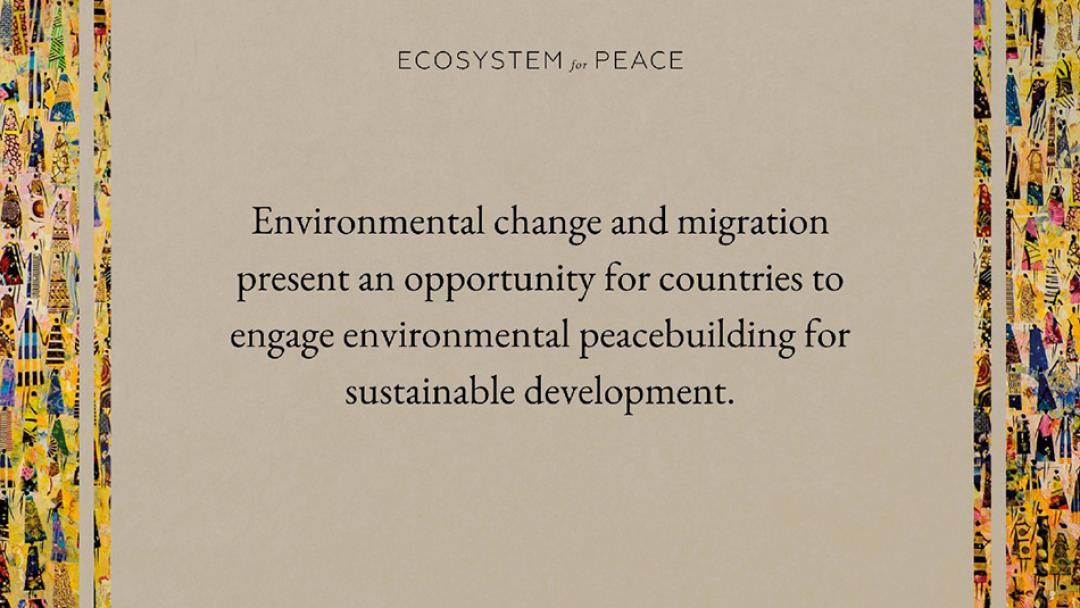
Environmental change and migration present an opportunity for countries to engage environmental peacebuilding for sustainable development.
By Mirali Shukla, Galeo Saintz, Elaine Hsiao and Richard Matthew
Movement has always been an integral part of the lives of humans and all other species. It is a complex and effective adaptive strategy that helps to maintain the health and wellbeing of countless ecosystems. Large marine megafauna make seasonal migrations to feeding and breeding grounds. Certain bird populations undertake mass migrations that coincide with local plant and insect blooms. Nomadic peoples have regularly traversed long distances since time immemorial. Migration is, and has been, dynamic: taking many forms and spanning a wide breadth of life. Yet, movement patterns are changing alongside the environment and climate, and the scale at which this change is happening is staggering. The Intergovernmental Science-Policy Platform on Biodiversity and Ecosystem Services (IPBES) estimates that up to 700 million people could be driven from their homes by 2050 due to changing land and climate conditions and science is telling us that more than 50% of all species other than humans are moving in response to environmental change. How do we then prepare for projected mass multispecies migrations? Firstly, by recognising that there are complex linkages between the diverse drivers and barriers of migration, with multiple push and pull factors that are influenced by environmental change, conflict, politics, and global development and conservation agendas. The different types and levels of impact that we are foreseeing are nuanced and multifaceted, calling for cooperation across sectors and a multi-disciplinary, multi-species approach. This article is a summary of insights from an upcoming report by IUCN CEESP Task Force on Migration, Environmental Change and Conflict and an article in the 2022 special issue on “Displacement” by the Annals of the AAG.
Sustainable Development in the Face of Environmental Change and Migration
Changes in the movement patterns and migration of humans and all other species have the potential to be highly disruptive for sustainable development on several levels.
Environmental change is a catalyst for forced displacement of vulnerable communities, and in turn, migration impacts on the state of our natural environment. In certain cases, for example as historically witnessed throughout Western colonization, human migration can be more detrimental to local wildlife populations than other types of damage associated with armed conflict, like landmines. These displacements affect the environmental and socioeconomic wellbeing of not just the destination, but also the origin and transit areas of all migrating species. Alternatively, those who cannot — or choose not to — move may have their security compromised by the degrading social and ecological conditions of their territories. Planned relocation may serve as a useful tool in some cases; for example, where existential threats to survival risk extinction or prohibit staying in place. However, resettlement poses several difficulties and threats to the rights of communities and nature in both origin and destination sites. Progress towards the Sustainable Development Goals (SDGs) has not fully considered the needs of different migrations at the scales projected.
Wide-scale, mass changes to the migration patterns of humans and all other species can also disrupt several social, economic and political frameworks. Increased cases of violent conflict, including human-wildlife conflict, threatened social cohesion, and impoverishment are some of several predicted impacts. When a community faces displacement and an increasingly scattered diaspora, women and children become especially vulnerable to both trafficking and violence. These changes could complicate or hinder SDGs initiatives and any progress made on them. However, there remain tangible and actionable measures that can be taken.
Moving Forward Together
Environmental change and migration present an opportunity for countries to engage environmental peacebuilding for sustainable development. Cooperative multi-stakeholder responses are needed in order to be effective in the face of such substantial challenges.
- Develop conflict-sensitive, rights-based multi-species frameworks and policies to prevent, prepare, manage and adapt for migration in several contexts.
- Through new partnerships with environmental, migration, humanitarian, development, planning and private sectors, we can move towards an integrated approach that accounts for the protection of biodiversity and ecosystem services, alongside the protection of vulnerable and marginalized peoples.
- As a steward of natural habitats worldwide, the conservation community in particular can embrace migration-aware approaches to planning within landscape-wide territories of engagement.
- Conflict resolution and peacebuilding for sustainable development need to embrace more-than-human environmental considerations in their strategies and interventions.
Rethinking traditional approaches and building bridges of dialogue across sectors could help to prepare for a planet on the move and develop necessary and inclusive strategies that will support sustainable development.
This post originally appeared in Medium. It is a contribution to a short series on opportunities for peace at Stockholm+50. To continue this conversation, visit: iucn.org/commissions/commission-environmental-economic-and-social-policy.